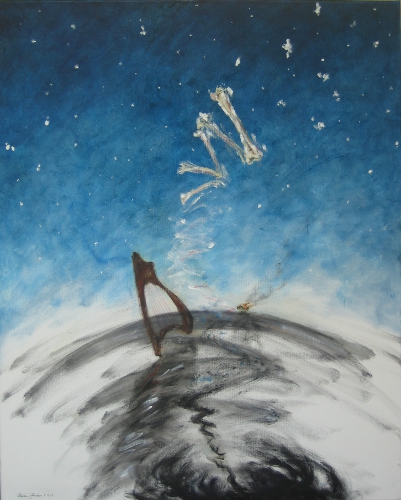I have always been drawn to the complex, intensely humane and deeply flawed characters in Greek mythology, and have made several paintings of based on several such figures, e.g. Minotaur, Daphne and Apollo, Helen of Troy, and Oedipus, etc.
One of my such efforts was an oil painting on the theme of Orpheus, one of the most famous musicians in human history, conceived while I was reading Rainer Maria Rilke’s Die Sonette an Orpheus.
That subject was a dangerous ground to tread into, because there were so many wonderful artworks had been created after this Orpheus myth, from paintings to operas; yet the lure of this myth and the reinterpretation by Rilke was so strong and irresistible, I pressed on.
My Orpheus was a collage of many variations of the much-told myth. My painting started with his descend into Hades to seek his beloved Eurydice, traveling on the River Styx. His lyre, which had persuaded Hades and Persephone to let Eurydice return to the earth, dominated the canvas. The lyre also took a shape of a strange animal, and was also a linkage to Apollo. After he had lost Eurydice for the second time, the grief driven Orpheus refused to entertain Dionysus’ followers who in their rages ripped him to pieces. His skull became an oracle and his flesh and bones were tossed into sky, scattered about and filled the universe with his music.
Thus the marriage of Apollonian and Dionysian spirits ushered in a new era.

The Song of Orpheus
oil on canvas, 30″x24″, 2010

I saw Orpheus as the means to bring joy and meaning to the world, through his irrepressible quest for love and his suffering, and ultimately his death. I saw his lyre singing and I saw his bones being scattered into the highest sphere, just like his notes would have crowned the heaven. Holy ointment burned in his skull, which had transformed into an oracle, rising up to dance with his ever higher notes. That’s The Song of Orpheus.
